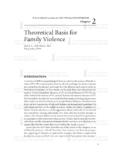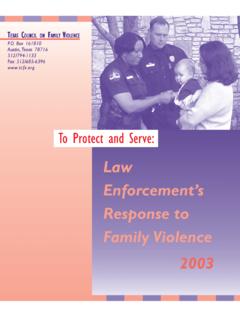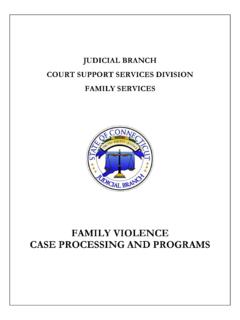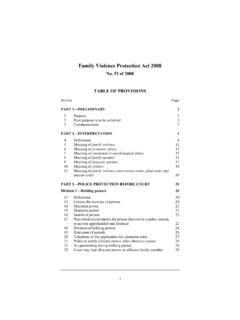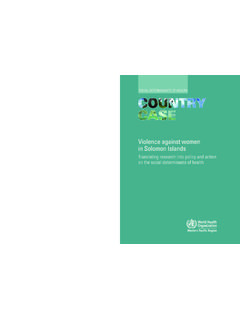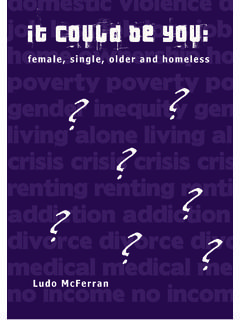Transcription of THE CYCLE OF VIOLENCE - 1736 Family Crisis Center
1 The Battered Woman by Lenore E. Walker: 1979 THE CYCLE OF VIOLENCE PHASE ONE: THE BUILD-UP PHASE The first phase is characterized by minor battering incidents and/or and emotional abuse over imagined or real infractions of rules and expectations of the male partner. The woman sometimes responds calmly, trying to de-escalate the situation or she may attempt to defend her position in the relationship. They may both attempt to rationalize away his behavior as stress reactions related to work or finances, etc. Often the woman believes her adapting behavior will act to control his VIOLENCE .
2 This tension building phase time lapse varies greatly from the relationship to relationship. For some it may be days or weeks, for others there may be years of tension building between acute incidents. As the tension builds, her coping skills may become less and less effective at protecting herself or de-escalating the tension. It is during this phase that women will often reach out for help or support since they are aware of the increasing danger. Other than services designed for battered women, many community services do not recognize her need at this stage since there is not evidence of VIOLENCE .
3 PHASE TWO: THE ACUTE BATTERING INCIDENT In the second phase, no controls are left, as the inevitable result of escalating tension and anger brings out the most abusive VIOLENCE . The acute battering incident is distinguished from other kinds incidents because of the intense discharge, major destructiveness, extreme emotional release at its most negative AND because this incident cannot be predicted or controlled in any way. The rage is so great that even the batterer isn t able to deny its presence, nor is the woman able to deny its effect on her.
4 As she senses this VIOLENCE coming on her anxiety and depression may also escalate. She may even try to trigger her batterer s VIOLENCE to relieve her own apprehension over not knowing when he is going to explode. Usually, however the acute battering is the result of the male partners choice to be violent. This phase is the briefest usually 2 to 24 hours. Afterwards there is denial about the severity of the incident or an attempt to minimize or deny the occurrence all together. If the police are called it is usually during this phase.
5 Women may also seek medical attention after the battering incident, although they may wait several days before getting that attention. PHASE THREE: THE RESPITE (*HONEYMOON PHASE) *Honeymoon Phase* is a phrase used by Lenore Walker in her book THE BATTERED WOMAN. During this phase the man may become very loving and exhibit tremendous kindness. He may also be apologetic and conciliatory offering to get help and promising never to be violent again. He wants to establish the hook which will keep her from leaving him. He will probably continue other forms of abuse though such as coercion, economic abuse, or emotional abuse in order to maintain his sense of control even during this phase.
6 This phase may embody everything she ever wanted from this relationship. He tells her he will change, and she hopes that she can perpetuate this third phase. This is the time when it is hardest for her to leave. It is also the time when most counselors and other services will become involved. Some will encourage her to stay and keep trying, others will tell her to leave him. CYCLE Of VIOLENCE Domestic VIOLENCE may seem unpredictable; however, it does in fact follow a typical pattern no matter when it occurs or who is involved.
7 The pattern, or CYCLE , repeats and can happen many times during a relationship. Each phase may last a different length of time and over time the level of VIOLENCE may increase. It is important to remember that not all domestic VIOLENCE relationships fit the CYCLE nor are everyone s experiences the same. Adapted from Lenore Walker, The Battered Woman, Harper and Row, 1979

